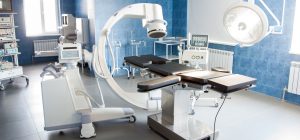The medical device sector means big things for the healthcare industry – and even bigger things for healthcare providers and their patients. Driven by technological innovation, an aging population and increases in chronic disease, the global medtech market is estimated to be worth $409.5 billion by 2023, according to a Research and Markets Forecast. However, while it represents a very lucrative opportunity for device producers, it’s not without its challenges.
Healthcare has undergone a significant shift in recent years with the rise of a value-based, positive-outcome model that challenges how device-makers think about their design. Medtech must produce products that cost less and do more without compromising safety or quality. There is also more demand for medical devices that are made with the end-user in mind – ones that can be easily operated by both healthcare staff and patients alike.
Steve Eichmann oversees design and usability of J&J’s medical devices and is a twenty-year industry veteran. He believes that things are changing but high caliber is the one constant. “Although external pressures are changing market dynamics, quality remains paramount [in medical devices],” Eichmann explained in a McKinsey interview.
“In addition to ease of use, clinical efficacy, and safety, they are looking for better outcomes, lower costs and patient satisfaction,” he added. “To meet these needs, designers and usability experts are trying to reduce complexity and variability and improve their reliability, patient outcomes and overall performance.”
The digital health trend is also contributing to growth of the medical technology market. As consumers increasingly embrace their role of ‘caretakers of their own health’, the lines between devices, drugs, data and software start to blur. Patient expectations for medical services become intermingled with their Amazon’s next-day-delivery mindset.
Despite the effectiveness of mobile technologies and IoT on the market today, many device makers have remained staunchly focused on hardware. According to an Ernst & Young ‘Pulse of the Industry’ report, only 16 of the 43 therapeutic devices that received FDA approval within the 18 months between January 2017 and June 2018 had incorporated digital health features or analytics capabilities.
“The problem with medtech is that it’s highly traditional,” said Henrik Norstrom, CEO of mobile health tech company Brighter AB. “[Product] development follows a traditional waterfall approach that serves only to exacerbate one of our biggest challenges: lead time from idea to market.”
Not everyone is averse to the advances that digital health brings, however. Many companies are embracing new ways to bring art to the science of building the next generation of medical devices. Medtronic, for example, is currently trial running their latest Guardian continuous glucose monitoring system with 460 patients diagnosed with both type 1 or 2 diabetes. It will only require calibration on the first day of patient wear and is expected to reduce patient fingersticks by 95 percent.
There has also been changes on the production side of things. Original equipment manufacturers (OEMs) are moving towards consolidation of their suppliers, factories, and equipment to become leaner. The biggest industry names are choosing strategic mergers and acquisitions to augment their products and services and gain bigger market shares while outsourcing technical and manufacturing needs to trusted partners to reduce their own overhead in these areas.
Consequently, contract manufacturing organizations (CMOs) are growing. It’s expected that the CMO market will reach $316 billion by 2023, a 10.5% compound annual growth rate (CAGR) and will expand their offerings to include everything from product design and additional manufacturing capabilities to final assembly, packaging and shipping.
CMOs are investing heavily in ‘industry 4.0’ technology such as robotics, tooling, automation, hybrid machine tools, 3D printing, advanced analytics, IoT and other ‘smart’ technologies to streamline their manufacturing processes. This allows OEMs to launch medical products more quickly and scale operations to meet demand.























